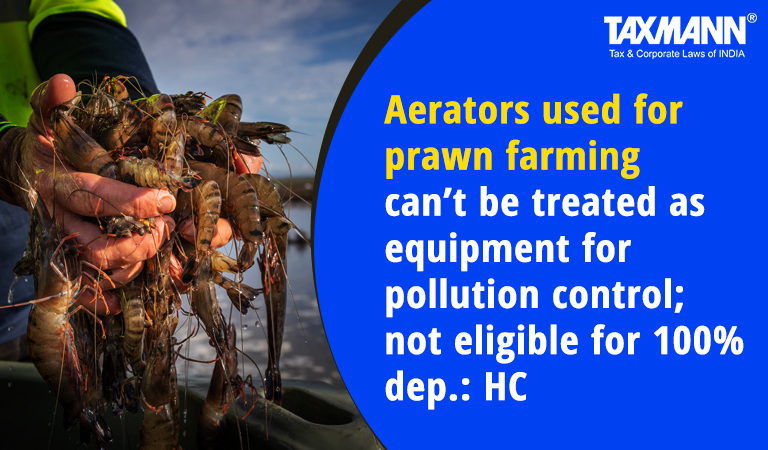Aerators used for prawn farming can’t be treated as equipment for pollution control; not eligible for 100% dep.: HC
- News|Blog|Income Tax|
- 2 Min Read
- By Taxmann
- |
- Last Updated on 6 January, 2022
Case Details: Industrial Incubators (P.) Ltd. v. DCIT - [2021] 133 taxmann.com 269 (Orissa)
Judiciary and Counsel Details
-
- Dr. S. Muralidhar, CJ. and A K. Mohapatra, J.
- B. Panda, Sr. Adv. for the Appellant.
- S.S. Mohapatra, Sr. Standing Counsel (IT) for the Respondent.
Facts of the Case
Assessee was in the business of prawn cultivation. Income-tax Returns (ITR) filed by the assessee were picked up for scrutiny by the Assessing Officer (AO). During the assessment, AO noticed that assessee had claimed 100 per cent depreciation on aerators.
The assessee claimed that said aerators were water pollution control equipment used to provide healthy growth of prawns. However, AO denied the benefit of 100 per cent depreciation on aerators and reduced it to 25 per cent. The Commissioner and Tribunal upheld the order of AO. Aggrieved-assessee filed the instant appeal before the High Court.
High Court Held
The Orissa High Court also upheld the findings of AO. It was noted that when the notice was issued to the suppliers of aerators, the suppliers were unable to clarify whether the Aerators were “technically fit to be treated water pollution control equipment” as defined under the IT Rules, 1962.
The AO also made a reference to the Central Pollution Control Board (CPCB) whether the technical devices used in the form of Aerators used by the Aquaculture farms could be considered as water pollution control equipment. The CPCB inter alia pointed out that Aerators are used for any purpose other than treatment of wastewater/sewage effluent/trade effluent. Thus, it may not be considered as a part of pollution control equipment and, accordingly, not eligible for tax benefits and concession.
The District Fisheries Officer was also issued a summons, and in his response, he disclosed that the effluent discharged from the prawn culture farm was harmful to the nearby areas. It was pointed out that Aerators “should be considered as aquaculture equipment and not the pollution control” equipment. Therefore, the claim of 100% depreciation on aerators wasn’t justified.
Case Review
-
- ITAT, Cuttack in IT Appeal Nos. 168 and 169/CTK/2001, dated 3-1-2001 (para 15) affirmed.
- Asstt. CIT v. Victory Aqua Farm Ltd. [2015] 61 taxmann.com 166/234 Taxman 598/379 ITR 335 (SC)(para 12) distinguished.
List of Cases Referred to
-
- Asstt. CIT v. Victory Aqua Farm Ltd. [2015] 61 taxmann.com 166/234 Taxman 598/379 ITR 335 (SC)(para 10)
Disclaimer: The content/information published on the website is only for general information of the user and shall not be construed as legal advice. While the Taxmann has exercised reasonable efforts to ensure the veracity of information/content published, Taxmann shall be under no liability in any manner whatsoever for incorrect information, if any.

Taxmann Publications has a dedicated in-house Research & Editorial Team. This team consists of a team of Chartered Accountants, Company Secretaries, and Lawyers. This team works under the guidance and supervision of editor-in-chief Mr Rakesh Bhargava.
The Research and Editorial Team is responsible for developing reliable and accurate content for the readers. The team follows the six-sigma approach to achieve the benchmark of zero error in its publications and research platforms. The team ensures that the following publication guidelines are thoroughly followed while developing the content:
- The statutory material is obtained only from the authorized and reliable sources
- All the latest developments in the judicial and legislative fields are covered
- Prepare the analytical write-ups on current, controversial, and important issues to help the readers to understand the concept and its implications
- Every content published by Taxmann is complete, accurate and lucid
- All evidence-based statements are supported with proper reference to Section, Circular No., Notification No. or citations
- The golden rules of grammar, style and consistency are thoroughly followed
- Font and size that’s easy to read and remain consistent across all imprint and digital publications are applied








 CA | CS | CMA
CA | CS | CMA


